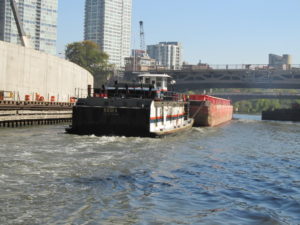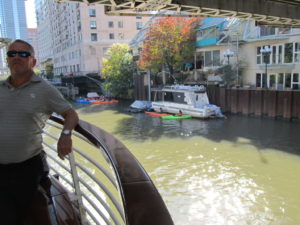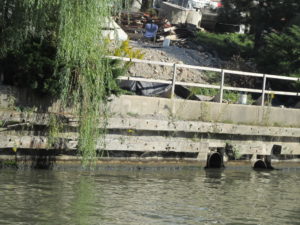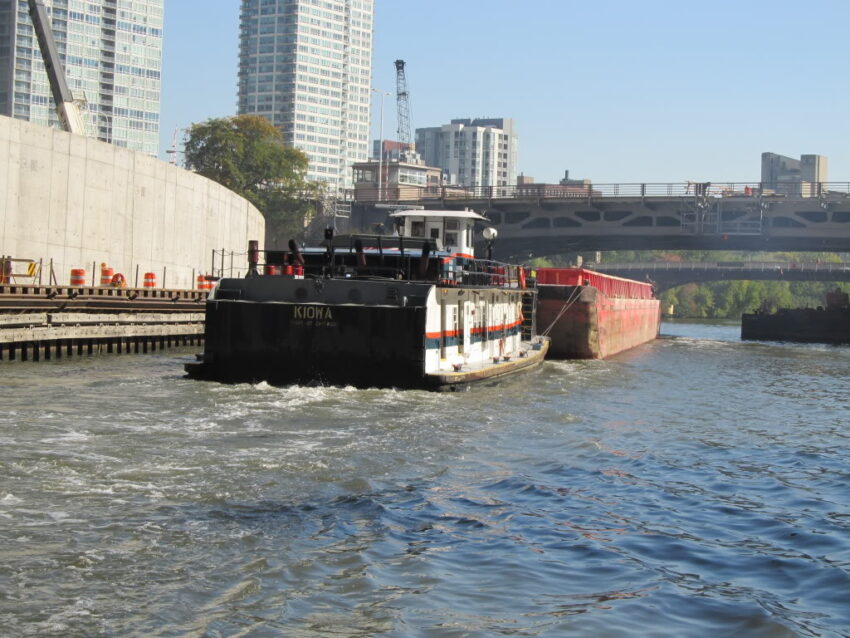When it comes to kayaking the Chicago River, some don’t give it a second thought, while others wonder if what they are doing is safe.
Erring on the cautious side, I pulled up a few blog posts from our past CASKA trip reports on the Chicago River that may help address concerns with the recent addition of four boathouses being built along the river.
Chicago River Canoe and Kayak: Because of the seawalls and larger boats in the main stem of the river, we prefer that you be confident you won’t tip over. Complete beginners may find the traffic a lot to handle… Children: under 10 are not allowed on this trip; ages 10-17 great discretion is advised. A parent must accompany these children, and some paddling experience is required.

CASKA trip report: Not A Lot Of Room For A Kayak–Stay Alert On The River (see last picture in article).
When I watched this WateridersVideo and read about the new boathouses this week I wondered about the recreational boats being used as well as the continued lure to bring young children and beginners in this area. On my 90 minute Architecture Cruise this fall the boat traffic was busy, big, and fast. One kayak tour waited huddled along the seawall, some holding onto parked boats, as many large boats made waves as they squeezed by to go under a bridge.
Unsafe recreational boats: CASKA trip report: “Lot’s of confidence and NO BULKHEADS!” At the parking lot we ran into a nice couple putting into the river in recreational boats. They had PFDs, lots of confidence and no bulkheads. I asked them how they would get back into their boats if they tipped over and they didn’t have a clue. I offered a few tips, pitched the CASKA safety center to them and hoped that love would conquer all….When we returned, I was heartened to see that the young couple’s car was gone, suggesting that they had returned safely.
Chicago Parent Article, 6/13/11: Imagine getting a view of the Chicago skyscape from a duck’s perspective. That is what participants in a kayaking tour of the Chicago River can expect….kayaking is a fantastic family activity adults and kids of all ages will enjoy.
Chicago Tribune: Shoreline water taxi captain Marcus Carson can rattle off stories about the close calls he’s seen on the Chicago River. He tells of kayakers who didn’t follow basic maritime rules, who disregarded horn signals or paddled too close to the choppy wake left by large boats like the one he pilots.

As more and more people are lured to kayak the Chicago River it will be good to share how to stay safe and choose the right place on the river due to your abilities.
CASKA Kayak Safety link: There are certain two word combinations in the English language that most of us among the living would prefer not having associated with our names. “Accident Report” and “Organ Donor” come to mind fairly rapidly. This is the beginning of a series of simple questions that you can ask yourself before you leave land to aid you in avoiding that rather dubious recognition. …I’m going to define recreational kayaks as those that are less than 14 feet in length that are made for calm water, near shore usage. They may not have hatches, bulkheads or a rudder and may have a large open cockpit. Generally speaking they have inadequate flotation to be paddled ashore when they are swamped – they’ll float, but not if they are trying to support your weight as well. Michael Gray
CASKA: Imposing walls along the Chicago River. The primary obstacle is that imposing wall along Wacker Drive—a sheer cliff rising at least 10 feet up from the water.
CASKA: Boat Traffic: Tour boats leave a significant wake, and the small rolling waves act as a stabilizer, incessantly, gently, pushing you closer to the wall. (However, when in doubt, Jay said, use your hips and tilt slightly and balance the boat.) Then again—you could just tie up on a pylon or row away with your food until you’re out of the boating traffic. There’s a low stone entranceway beside O’Brien’s Riverwalk Cafe; and an old rusty ladder near Dearborn Street. Either would work as temporary anchors.
CASKA: Chicago River Paddle: ….We did not paddle on the main branch because of the heavy tour boat traffic. I personally found paddling in the downtown area architecturally and scenically spectacular, but was made slightly uncomfortable from the high volume of tour boat traffic.
CASKA: Kayaking Chicago’s Shores: I …expressed my concern for future boat traffic and possible hazards in the area to watch for. …Coincidentally, as we headed south near the next harbor a motorboat came peeling out without warning. …At the end of our trip we practiced some rescues in the harbor. It is recommended that all kayakers should practice self- and assisted rescue techniques until they are routine. I’ll have to admit; too often I just forget what I learned because I never do it again….

Fortunately there are less busy parts of the Chicago River but then there is still the concern about the water quality. Since he took office in May, Emanuel has vowed to clean up the river, but he declined to address if the river would ever be swimmable—Sun Times.
The main concern for water contact recreation generally is bacterial levels. While bacteria are integral parts of any natural system, some kinds, in sufficient numbers, can cause gastrointestinal illiness, skin and ear infections, respiratory illiness, and sometimes worse problems. Bacteria levels can change rapidly with rain and storms. The odds of a person getting sick increase with the amount of bacteria that enter the body. A small amount is unlikely to affect most people—boating where people may get splashed occasionally, is much less risky than swimming.
To limit any risk, don’t enter the water for several days after a significant rainstorm. Storm flows spike bacteria, which decrease after several days. Don’t swallow water. Don’t enter the water if you have cuts or open sores. These are pathways for bacteria to enter your body. Wash after swimming. People should exercise caution, especially children, the elderly and anyone with a compromised immune system.
On August 18, 2011, the IllinoisPollution Control Board adopted rules establishing recreational use designations for the Chicago Waterway System (CAWS) and the Lower Des Plaines River (LDPR). The rule created four categories of recreational use designation for the CAWS and the LDPR: Primary Contact Recreation, Incidental Contact Recreation, Non-contact Recreation, and Non Recreation.
Here I am momentarily “up creek without a paddle.” What else is wrong with this picture of me with family a few years ago when I was a beginner? Where are our PFDs? The water in this area was very deep and look at the cliffs behind us—no shoreline. My son, on the far left, tipped his kayak at least 5 times because he has a big torso. At least we had an experienced guide along that day and kayaks with bulkheads. The fast current behind our boats accidentally took my paddle downstream during this shot and we had to go retrieve it. I had no extra paddle! Oops. I got in the habit of no PFD and getting a tan for quite awhile until the following year when I took a kayak lesson and read over my list of required equipment to bring on my first kayak expedition. I did get a spare paddle to have after that day, however.
Four New Boathouses: The four boathouses, which cost about $4 million each, will provide kayaking and concessions, and will be built within two years, city officials said. The idea is to pay more attention to Chicago’s other major body of water and “make the river not something you drive over, but something you bring your kids to,” Emanuel told reporters at a South Side park, one of the future boathouse sites, which will be funded half by private and half by city money….Still, advocates who have sued the district are worried that disinfecting wastewater isn’t a guarantee the water will be swimmable. They note that there are other ways sewage can get into the water, such as when heavy rainfalls overwhelm the sewer system. Emanuel and U.S. Environmental Protection Agency Administrator Lisa Jackson, who also attended, declined to discuss in detail any concerns about water quality, saying many kayakers already make use of the river. Since he took office in May, Emanuel has vowed to clean up the river, but he declined to address if the river would ever be swimmable. Chicago Sun Times
CASKA Kayak Safety: Err on the side of caution, especially when paddling solo. The greater your training and paddling experience the greater the range of conditions you should be able to handle with relative safety. Many of these clubs/businesses/retailers offer lessons. Participate in these whenever possible – they are excellent ways to improve kayaking skills and techniques. See the organizations’ websites for details: Chicago Kayak ; Geneva Kayak Center ; Great Lakes Kayak ; Kayak Chicago ; Lincoln Park Boat Club ; The Northwest Passage .
**March 27-28, 2012: Chicago River Waterway Risk Assessment by Tom Heineman. A two day Risk Assessment of the Chicago River waterway sponsored by the U.S. Coast Guard. I officially represented CASKA and unofficially represented the non-commercial paddling community using the Chicago River. Dave Olson (Chicago Kayak) and Charles Portis (Water Riders) represented the commercial tour and kayak rental businesses operating on the River. Susan Urbas represented the nonprofit Chicago River Rowing and Paddling Center and the Port Development Safety Council. Some of the mitigations that were proposed were:
- better screening of clients renting kayaks
- education of renters as to the rules of the river and the hazards inherent in paddling on the Chicago River
- classification of sections of the river by color code (similar to ski runs – green, blue, black)
- signage at access points with safety considerations and hazards inherent in different sections of the river
- signage at critical points on the river oriented towards kayak safety
- maps with hazard identifications at both access points and to be handed out by vendors to their clients
- better DNR screening of vendors being licensed to rent kayaks and non-renewal of licenses of problem vendors
- emergency egress points along the river (such as ladders) in sections of the river where escape from the water is nearly impossible
- formalization of the Port Development Safety Council so they can exercise more influence in addressing continuing concerns on the river
**Up-date: Kayak tours were caught on the Chicago River when a severe storm hit the area. Some of the kayaks capsized in the river, while others were stranded against the walls of the river. More than 60 people, including children, were rescued. Wall Street Journal Online ; Chicago Tribune, July 1, 2012. ; CBS Chicago.

